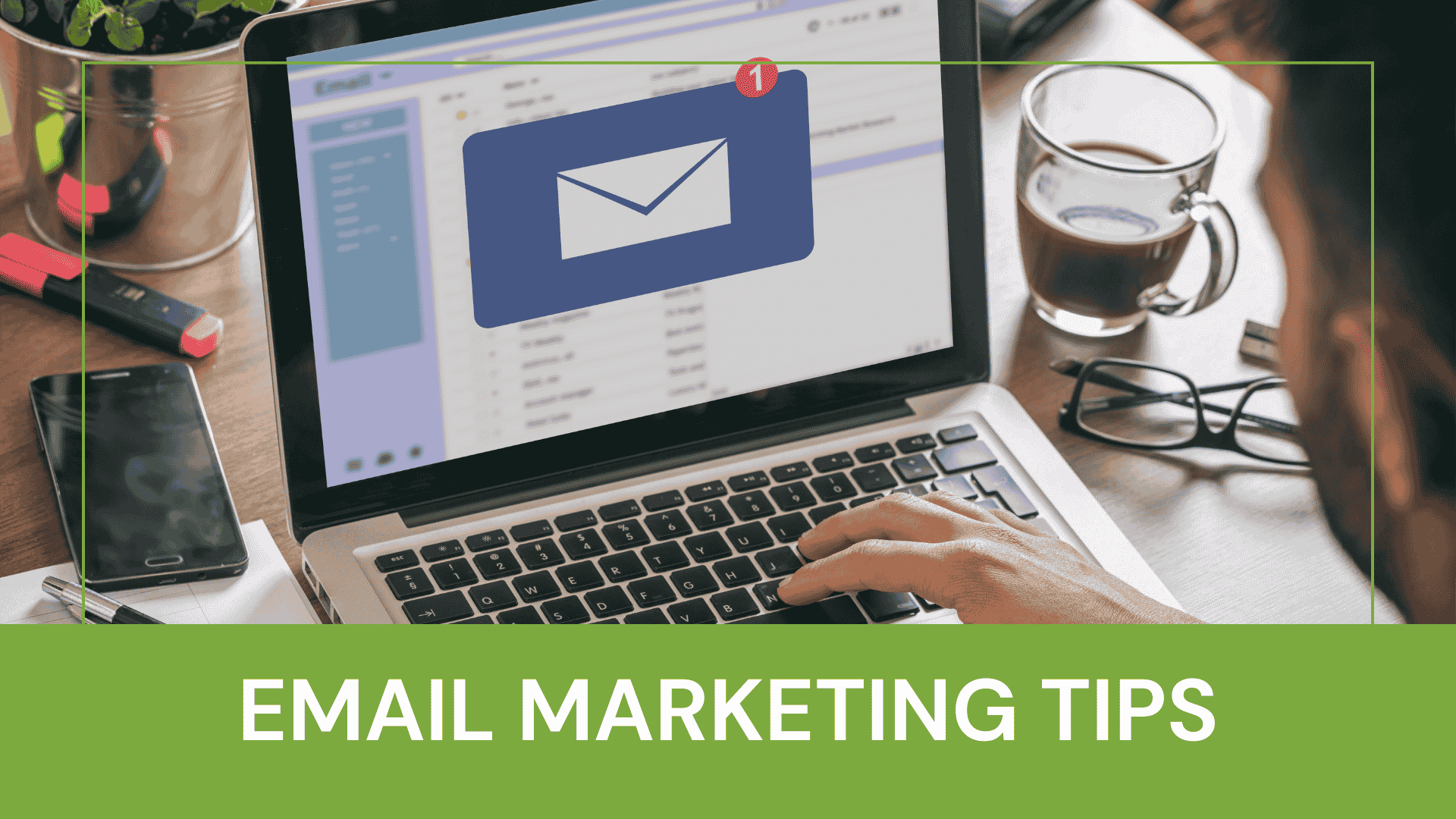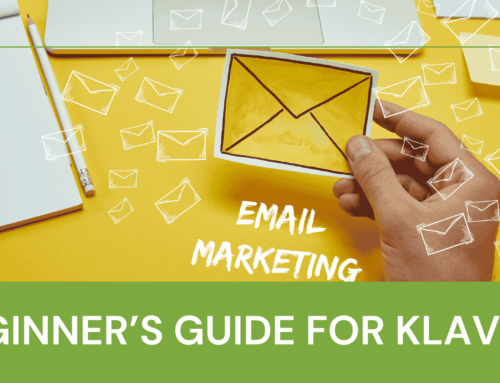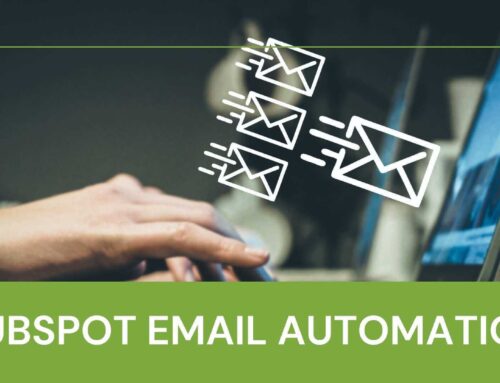Email Marketing Tips & Techniques
Email marketing remains one of the most effective ways to reach your audience, nurture leads, and drive revenue. But to truly maximize its potential, you need to master the art of crafting and delivering emails that resonate with your audience.
In this article, we’ll explore the best practices for email list segmentation, deliverability tips, subject line strategies, CTAs, and more to help you take your email marketing to the next level.
1. Boost Deliverability with These Email Health Tips
Even the most well-crafted email won’t succeed if it doesn’t land in your recipient’s inbox. Here are some tips to ensure your emails are delivered successfully:
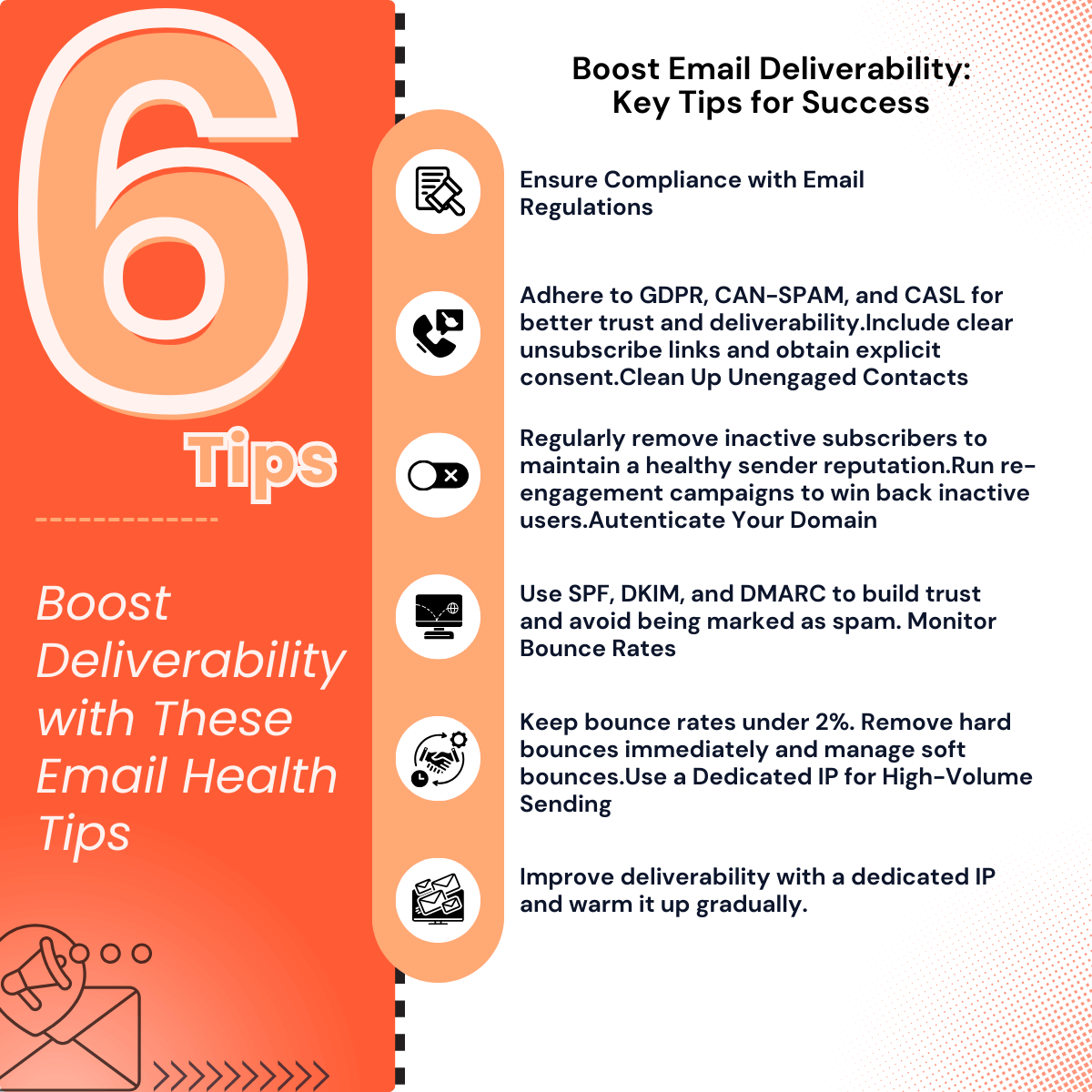
a) Ensure Compliance with Email Regulations
Email regulations are in place to protect consumers from spam and ensure that companies only send messages to those who want to receive them. By adhering to these rules, you not only stay legal but also build trust with your audience and improve your deliverability.
Here’s how to do it:
- Include a clear unsubscribe link in every email.Only email people who have opted into your list.
- Follow regulations like GDPR, CAN-SPAM, and CASL.
GDPR (General Data Protection Regulation): If you’re sending emails to anyone in the EU, ensure you’re collecting consent properly and allowing recipients to easily access, update, or delete their personal data. Violating GDPR can result in hefty fines, which can harm your reputation and cause deliverability issues.
CAN-SPAM Act: For US-based email marketing, always provide a clear and visible way to unsubscribe from emails. Ignoring this can lead to fines and blacklisting.
CASL (Canada’s Anti-Spam Legislation): For Canadian contacts, ensure you get explicit consent before sending promotional emails. This includes confirming that recipients are aware of the purpose for which their data will be used.
b) Clean Up Unengaged Contacts
A clean email list is essential for maintaining a good sender reputation. Sending to uninterested or inactive subscribers can significantly damage your sender score, which in turn harms deliverability.
- Regularly Remove Inactive Subscribers: Over time, you’ll accumulate contacts who haven’t opened or engaged with your emails. Periodically clean your list to ensure you’re only emailing active recipients.
- Run Re-engagement Campaigns: Before you remove these inactive users, give them a chance to stay on your list. A re-engagement campaign with an attractive subject line or special offer can help encourage users to reconnect with your brand.
c) Authenticate Your Domain
Email authentication protocols play a critical role in ensuring your emails are trusted by email service providers (ESPs) and not marked as spam.
SPF (Sender Policy Framework): SPF records allow the recipient’s email server to verify that the email came from an authorized server. If you don’t have an SPF record, your emails are more likely to be flagged as spam.
DKIM (DomainKeys Identified Mail): DKIM adds a digital signature to your emails that proves they haven’t been tampered with during transit. This is essential for preventing spoofing and building trust with your recipients.
DMARC (Domain-based Message Authentication, Reporting, and Conformance): DMARC tells email providers how to handle emails that fail SPF or DKIM checks. It helps protect your domain from being spoofed, which could harm your sender reputation.
d) Monitor Bounce Rates
A high bounce rate can signal to email providers that you’re sending low-quality emails, which can damage your reputation and decrease deliverability.
- Hard Bounces vs. Soft Bounces: Hard bounces occur when emails are sent to invalid or non-existent email addresses, while soft bounces are caused by temporary issues, like a full inbox. It’s critical to differentiate between the two.
Hard Bounces: These should be removed immediately from your list. Continuing to send emails to invalid addresses will lead to increased bounce rates and possible blacklisting.
Soft Bounces: If the email soft-bounces several times, remove or segment these contacts after a few attempts to prevent long-term issues. - Bounce Rate Benchmarks: Keep your bounce rate under 2%. If it’s higher than that, take a closer look at your list management and segmentation practices.
e) Use a Dedicated IP for High-Volume Sending
If you’re sending a large volume of emails, using a dedicated IP address for your campaigns can help improve deliverability. Shared IPs can lead to issues if another user on the same IP engages in spammy behavior.
- Dedicated IPs: If you’re sending high volumes of email, using a dedicated IP ensures you’re in full control of your sender reputation. This can help ensure that your emails are delivered and not affected by other senders.
- IP Warming: If you’re using a new dedicated IP, gradually increase your sending volume over time. This process, called IP warming, ensures that your IP builds a positive reputation with email service providers.
Bonus Tip: Consider using an ESP that offers dedicated IP addresses if you’re sending more than 100,000 emails per month.
2. Best Practices for Email List Segmentation
Segmentation is the cornerstone of successful email campaigns. By dividing your audience into smaller, targeted groups, you can send personalized messages that truly connect.
a) Segment by User Behavior
Identify how your subscribers interact with your brand.
- Are they browsing your site?
- Adding items to their cart?
- Making frequent purchases?
Use this data to create tailored campaigns, such as abandoned cart reminders, product recommendations, or exclusive offers for repeat buyers.
b) Demographic Segmentation
Demographics like age, gender, location, or industry provide invaluable insights. For example:
- Send time-sensitive offers to recipients based on their time zones.
- Promote products or services based on age-specific preferences.
c) Leverage Purchase History
Past purchases can reveal a lot about a subscriber’s interests and needs. Use this data to:
- Upsell complementary products.
- Reward loyal customers with exclusive discounts.
3. Tips for Crafting Irresistible Subject Lines
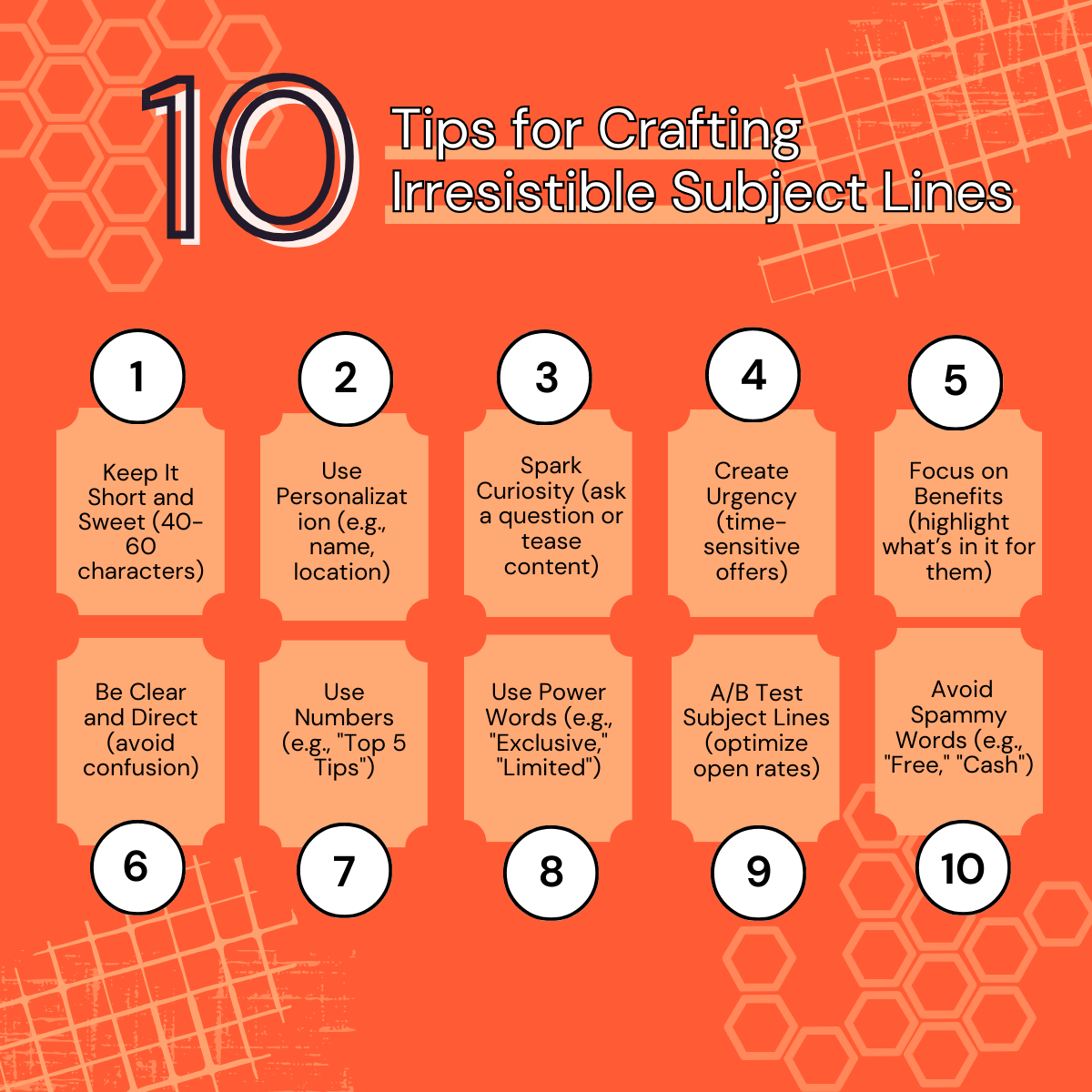
Your subject line is the first thing recipients see, and it determines whether they’ll open your email. Here’s how to make it count:
Keep It Short and Sweet
Aim for 40-60 characters to ensure your subject line isn’t cut off, especially on mobile devices.
Use Personalization
Include the recipient’s name or a detail relevant to them (e.g., location or past purchase). Example: “John, Don’t Miss Out on This Exclusive Deal!”
Spark Curiosity
Ask an intriguing question or tease what’s inside. Example: “Can’t Sleep? Try These 5 Tips Tonight”
Create Urgency
Use time-sensitive language to encourage immediate action. Example: “Last Chance: 50% Off Ends Tonight!”
4. Key Elements of a Strong CTA (Call-to-Action)
Your CTA is what drives action, whether it’s making a purchase, signing up for a webinar, or downloading an eBook. Here’s how to make your CTAs stand out:
Be Clear and Direct
Use action-oriented language like “Download Now”, “Shop the Sale”, or “Get Started Today”.
Make It Stand Out
Use contrasting colors for your CTA button to draw attention.
Ensure the button is mobile-friendly and easy to click.
Create a Sense of Urgency
Phrases like “Limited Time Offer” or “Act Now” prompt immediate action.
Keep It Relevant
Align your CTA with the email’s content. For instance, if you’re sharing a blog post, use a CTA like “Read More” instead of “Shop Now”.
5. Effective Email Marketing Tips for Increased Revenue
Now that you’ve segmented your list, optimized your deliverability, and crafted engaging subject lines and CTAs, here are additional tips to maximize your email marketing ROI:
Provide Value in Every Email
- Share useful content, such as how-to guides, industry insights, or exclusive offers.
- Avoid being overly sales-focused in every email; balance promotional content with educational value.
Optimize for Mobile
- Over 50% of emails are opened on mobile devices. Use responsive design and concise text for a seamless mobile experience.
A/B Test Everything
- Test different subject lines, CTAs, email layouts, and sending times to determine what resonates best with your audience.
Use Automation
Set up workflows for:
- Welcome emails for new subscribers.
- Post-purchase follow-ups.
- Re-engagement campaigns for inactive subscribers.
Monitor and Analyze Performance
- Track metrics like open rates, click-through rates, and conversions.
- Use this data to refine your strategy and improve future campaigns.
Final Thoughts
Mastering your emails isn’t about sending more; it’s about sending smarter. By segmenting your list, maintaining email health, crafting compelling subject lines, creating strong CTAs, and following effective email marketing strategies, you’ll build stronger connections with your audience and drive greater revenue.
Start implementing these tips today and watch your email campaigns soar. Remember, success in email marketing lies in consistently delivering value to the right people at the right time.

